Ready to work smarter, not harder? Agile tools are game-changers in project management. They boost efficiency. They streamline workflow. Most importantly, they help teams adapt to change fast. Imagine a tool that helps you see the big picture without losing sight of the details. That’s Agile for you!
Did you know, organizations that consistently implement project management practices achieve a remarkable 92% success rate in meeting their project objectives?
With Agile tools, gone are the days of drowning in spreadsheets and endless email threads. Say hello to real-time collaboration. Say hello to progress you can track at a glance. These tools make work life simpler and goal achievement faster.
Whether you’re new to Agile or a seasoned pro, you’ll want to know how these tools can take your projects to the next level. Keep reading. You’re about to unlock the secret to smarter work.
Quick List of 5 Agile Tools
- Onethread: A collaboration tool that consolidates messages, tasks, and files into a single conversation thread.
- Trello: Visual board-based tool great for managing tasks and workflows with a drag-and-drop interface.
- Asana: Flexible project management tool that offers timelines, task assignments, and collaboration features.
- ClickUp: All-in-one platform offering task management, time tracking, and goal-setting capabilities.
- Monday.com: Customizable work OS for managing project workflows, and automating routine tasks.
Our reviewers evaluate software independently. Clicks may earn a commission, which supports testing. Learn how we stay transparent & our review methodology
Comparison Chart Of Agile Tools
Here’s a quick comparison to help you pick the right Agile tool for your needs.
Tools | Task Management | Sprint Planning | Time Tracking | Collaboration Features |
 | Simplify task management by centralising all tasks in one place | Available with detailed sprint report | Time Sheet, real-time dashboard | Team discussion, Task specific comments, announcements and file sharing |
 | Employs boards, cards, and lists for project management. | Trello cards, Sprint Planning, Keep all code, specs, and plans | Time Blocking, One-click time tracking, Detailed reporting, Attendance and work schedule management | Simple drag-and-drop,organizes your projects into boards. |
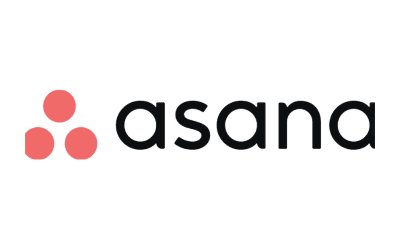 | Detailed task assignments,Drive cross-team efficiency | Sprint Planning Template, milestones, launch dates, and backlog | Make an estimate, Measure exactly, Track multiple sessions | Coordinating work,Communicate effectively,Aligning on shared goals. |
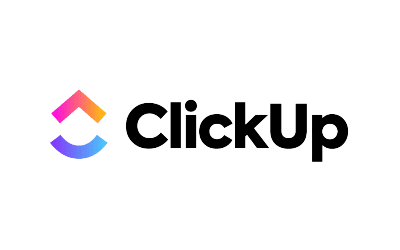 | Tasks Breakdown, Docs Create, Whiteboards | Set sprint dates, assign points, and mark priorities | Built-in time tracking, Create and edit time entries | Multiple assignees, Edit docs, Instant and Live Collaboration |
 | Task boards and automations, to-do list, Color-coded columns for visual task status | Sprint, Planning Template, Multiplan Sprints in One Place | start and stop the timer , Tracking time in Subitems | visual boards, track of tasks and helps you monitor progress. |
What is Agile Tools?

Agile tools are software applications designed to facilitate Agile project management. These tools help teams plan, track, and manage Agile projects, following flexibility, collaboration, and iterative development principles.
They offer features such as task boards, sprints, and burndown charts to ensure a project’s success. Agile tools are key for any team wanting to implement Agile methodologies like Scrum, Kanban, or Lean.
They aid in enhancing productivity, monitoring progress, and delivering high-quality outcomes. Overall, Agile tools are essential for keeping an Agile project organized and on track.
How Agile Tools Can Help Your Business?

Agile tools offer a myriad of benefits that can significantly impact your business in a positive way. Drawing insights from research, here are the core advantages:
- Faster Time to Market: Agile tools help you move quickly from planning to execution, shortening the product development cycle.
- Quick Adaptation: Agile tools allow your team to adapt swiftly to changing requirements or customer feedback, ensuring better end products.
- Higher Productivity: These tools automate many tasks in the Agile process, saving time and increasing team efficiency.
- Enhanced Collaboration: These tools provide platforms that foster real-time communication among team members, leading to better outcomes.
- Customer Satisfaction: With Agile tools, businesses can easily adapt to customer feedback, leading to products that truly meet user needs.
- Cost-Efficiency: By enabling incremental development and prioritizing high-value functions, Agile tools help optimize resource allocation.
- Risk Management: Continuous evaluation features within Agile tools allow teams to identify and tackle issues early, minimizing project risks.
Utilizing Agile tools can revolutionize how your team works, streamlining processes and leading to better, faster results.
Key Features to Consider in Agile Tools

Looking for Agile tools? It’s crucial to pick the right features. Here’s a breakdown of key elements you should look for: Progress visualization, Issue tracking, Collaboration, Estimation, and Customer portal. Let’s dive into each one.
Sprint Planning
Sprint planning is a key feature to consider in Agile tools. It helps in breaking down larger tasks into smaller, manageable units to be completed in a fixed timeframe. This enhances focus, ensures accountability, and aids in timely project completion.
Performance Tracking
One of the most crucial features is performance tracking. This allows you to measure a project’s progress status and gauge each team member’s performance. It ensures that everyone is on track and helps in making informed decisions.
Issue Tracking
Problems happen. You need a way to track them. Issue tracking allows you to flag, categorize, and resolve issues efficiently. No more scrambling through email chains to find that one bug report. Everything’s organized and accessible.
Teamwork
The ability to collaborate within the tool itself is a big plus. This feature eliminates the need for email sharing and fosters a more seamless exchange of information among team members. The result is improved teamwork and a more cohesive final product.
Estimation
Estimation helps you plan better. It’s about predicting time and resources. Many Agile tools offer built-in estimators. You input your parameters, and the tool gives you a time frame. This helps in setting realistic deadlines.
Customer Portal
Don’t forget the end-user. A customer portal allows clients to submit requests or feedback. They can track the status of their queries. This adds a layer of transparency and improves customer satisfaction.
Choosing the right features in your Agile tools can make all the difference. Keep these key points in mind, and you’ll find a tool that aligns with your needs.
Top 5 Agile Tools
Looking for the best Agile tools to elevate your project management? Here’s a quick rundown of the top 5 Agile tools that are turning heads and driving results:
#1. Onethread
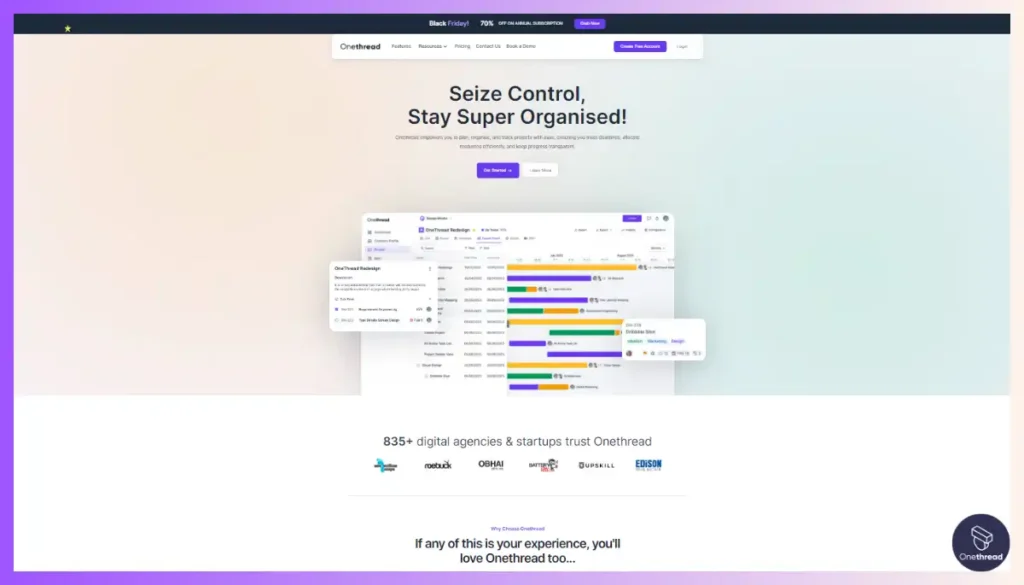
Meet Onethread, a top contender in the Agile tools market. What sets it apart? Its unique approach to simplifying project management. Onethread consolidates messages, tasks, and files into a single conversation thread.
Imagine having all your project elements in one place, creating a seamless flow of information. No more juggling multiple apps or sifting through endless emails. With Onethread, streamlined task management and real-time communication are rolled into one platform.
It offers native time tracking, focuses on task and communication consolidation and makes it a standout choice for teams who want a more organized and efficient workspace. Onethread takes the complexity out of Agile management, making your life easier.
Try Onethread
Experience Onethread full potential, with all its features unlocked. Sign up now to start your 14-day free trial!
Overview and key features
On the hunt for an Agile tool that cuts through the noise? Look no further than Onethread. This tool streamlines your work by putting everything in one place. Let’s discuss its key features: task management, real-time communication, and file sharing.
Sprint Planning
OneThread offers key Agile features for smooth project flow. It excels in backlog management and enables real-time team collaboration. Its user-friendly sprint planning feature allows drag-and-drop task assignments and quick status updates. OneThread’s dashboard provides clear insights into team progress, making it a go-to Agile tool.
Task Management
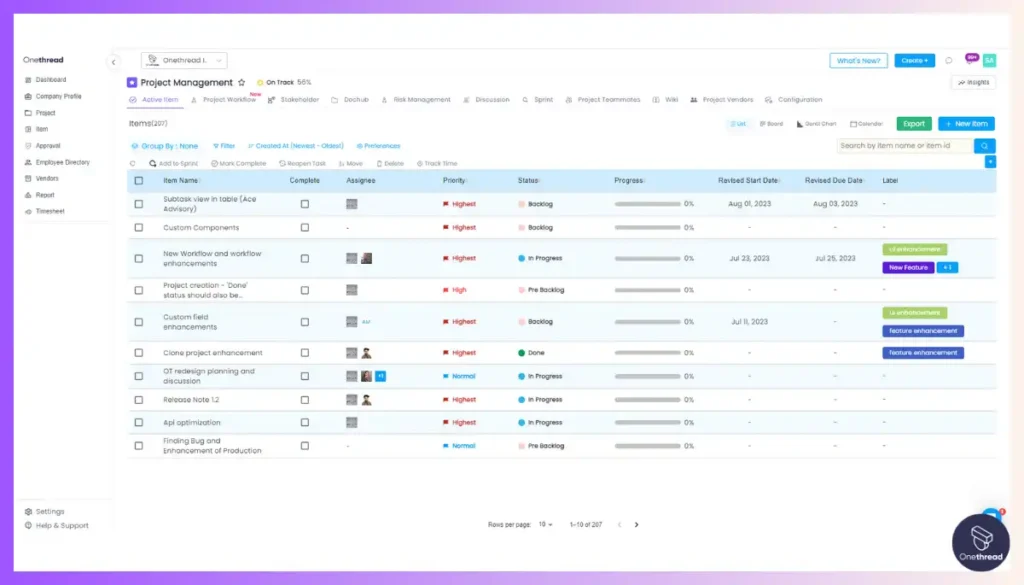
No more hopping between apps. Onethread brings all tasks into a single thread. You can assign, update, and track tasks effortlessly. You’ll always know who is working on what. The clarity it offers is invaluable.
Real-Time Communication
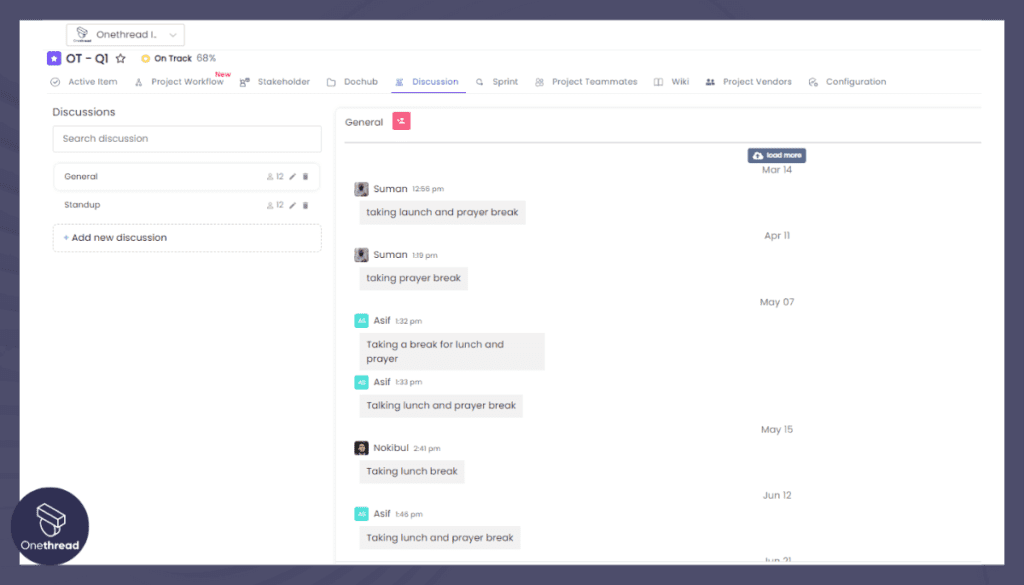
Messaging is built right in. When a task is updated, everyone involved gets notified. This instant communication minimizes delays. No need to switch to a messaging app or send an email. It’s all there in the same thread.
File Sharing
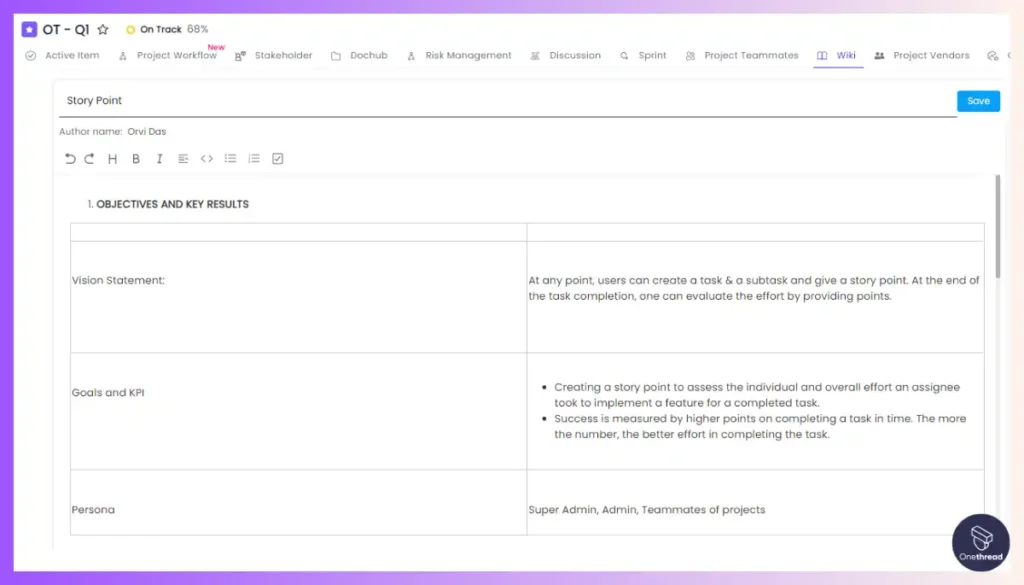
Attachments are simplified. Whether it’s documents, images, or spreadsheets, they all go into the same thread. This means you don’t have to search through different folders or emails to find what you need. Everything is within reach.
User Experience
Onethread is designed with the user in mind. Its interface is intuitive, making navigation a breeze. This ensures that team members can adapt to the tool quickly. Less time learning means more time doing.
Onethread stands out by simplifying what other Agile tools complicate. Its focus on single-thread management for tasks, messages, and files makes it a go-to option for teams seeking efficiency.
Pricing plans and options

Let’s take a closer look at the Free, Growth, and Scale plans.
Free Plan
Perfect for freelancers or small teams just getting started. The Free Plan includes:
- Basic task management
- Single-thread conversations
- Limited file storage
It’s a great way to test the waters without committing financially.
Growth Plan – $3.6/month
Stepping up your game? The Growth Plan offers:
- Advanced task management features
- Unlimited threads
- Increased file storage
- Priority customer support
At just $3.6 per month, this plan adds value without breaking the bank.
Scale Plan – $6/month
Need the full suite? The Scale Plan has you covered:
- All features from the Growth Plan
- Additional admin controls
- API Access for custom integrations
- Dedicated customer support
Try Onethread
Experience Onethread full potential, with all its features unlocked. Sign up now to start your 14-day free trial!
#2.Trello
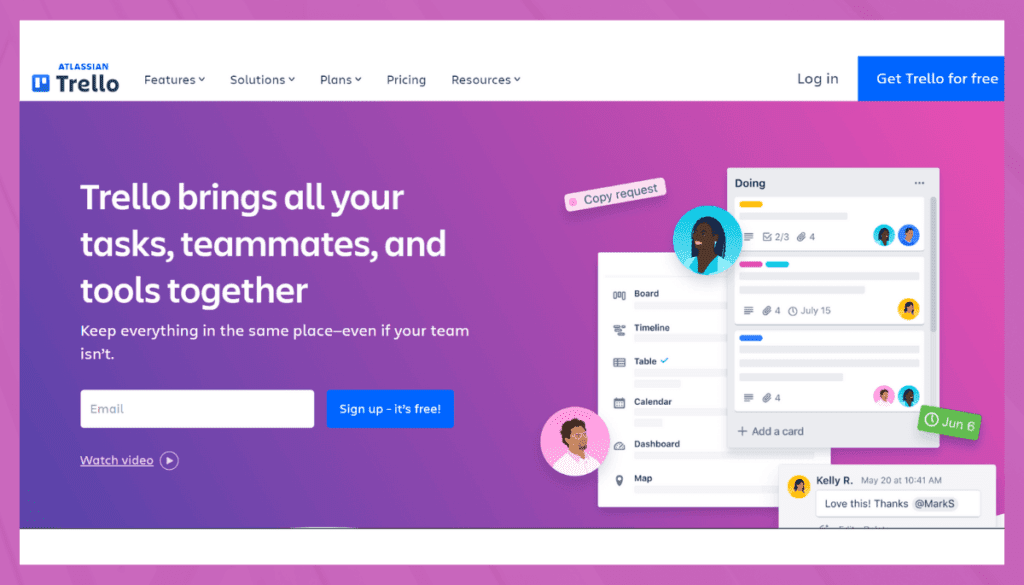
Trello is a versatile project management tool that simplifies task organization. With its user-friendly interface, Trello makes collaboration effortless. It employs boards, lists, and cards to streamline workflows.
You can create tasks, assign them, and set deadlines easily. Trello also supports file attachments and integrates with various apps like Google Drive and Slack for enhanced productivity. Its visual approach allows you to see the big picture while managing the details.
Plus, it offers mobile apps for on-the-go management. Whether you’re working solo or in a team, Trello helps you stay organized and efficient. Try it today to experience seamless project management.
Trello – Overview
Product Information:
- Company Valuation: $425 million.
- Employee Numbers: 114 Employees
Founding Team:
Founders Michael Pryor and Joel Spolsky.
Features
This platform has made Agile easier to implement, thanks to its flexible boards, cards, and lists. Let’s explore its key features, pros and cons, pricing, and what customers have to say about it.
Visual Board-Based Task Management
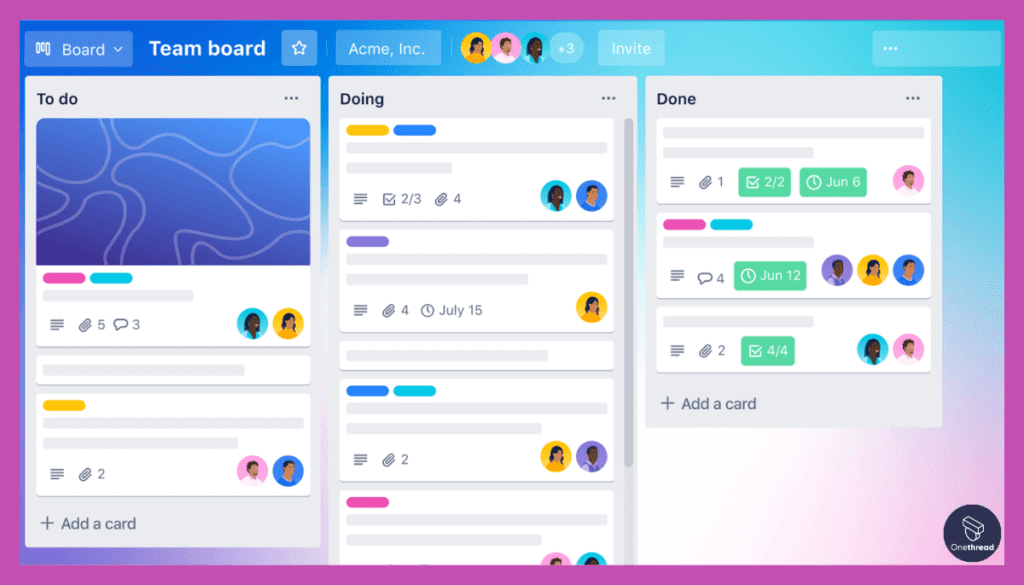
The heart of Trello lies in its visual boards. With boards, you can easily manage tasks and workflows using cards and lists. Each card can represent a task, and you move it across lists to indicate progress. This is incredibly intuitive and makes project statuses easily understandable. Teams can see what’s happening at a glance, without the need to read through complicated spreadsheets or long email threads.
Drag-and-Drop Interface
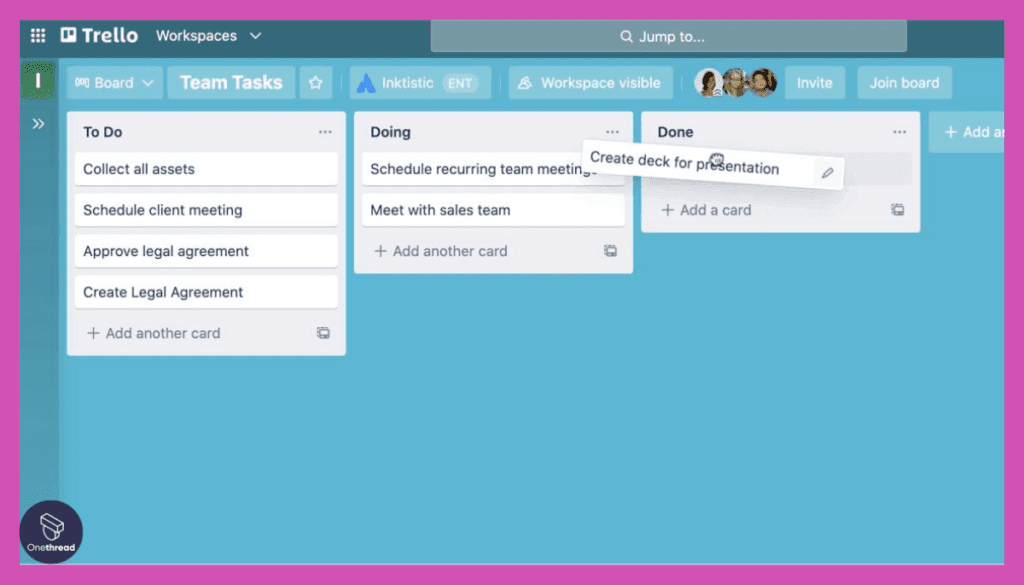
Trello’s drag-and-drop interface is as simple as it sounds. You can move cards from one list to another effortlessly. The drag-and-drop feature makes task assignments and workflow adjustments super easy. This simplicity encourages team members to actively participate in project management, which is a vital aspect of Agile methodologies.
Real-time Collaboration
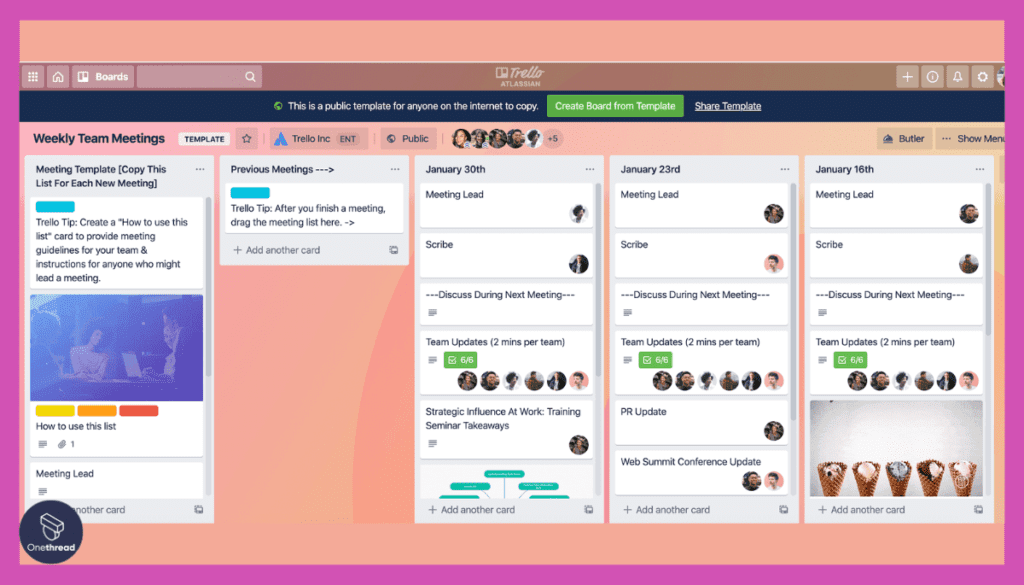
The platform excels at real-time collaboration. Team members can comment on cards, attach files, and even tag each other. This creates a rich, real-time dialogue about tasks and projects without the need for separate messaging apps. Real-time collaboration ensures that everyone stays updated and issues are addressed immediately.
Customizable Templates
One of Trello’s standout features is its customizable templates. Teams can save a lot of time by using pre-made templates for common workflows or creating their own for recurring projects. This customization makes Trello adaptable to any project type or industry, enabling quick setup and execution.
Power-Ups and Integrations
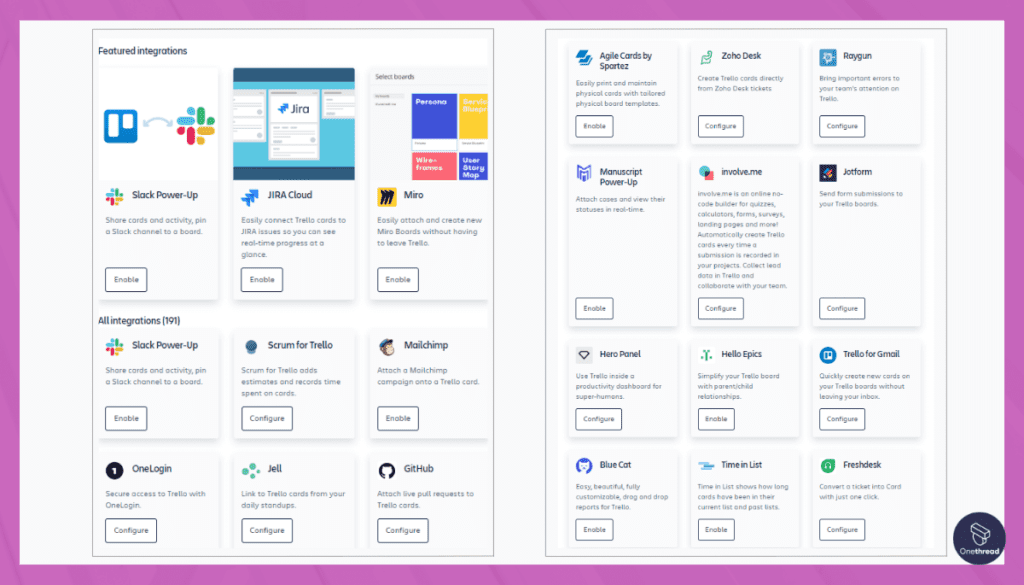
Trello isn’t just a standalone tool; it can integrate with various other tools and services, thanks to its Power-Ups feature. You can link your Trello boards with apps like Google Drive, Slack, and more. This extends the functionality of the tool, making it a more comprehensive solution for project management.
Pros & Cons
Pros:
- User-friendly and intuitive interface.
- Extensive customization options.
- Robust collaboration features.
- Wide array of integrations.
Cons:
- Limited features in the free plan.
- Can get cluttered for complex projects.
- May require third-party integrations for advanced functionalities.
Pricing Plans
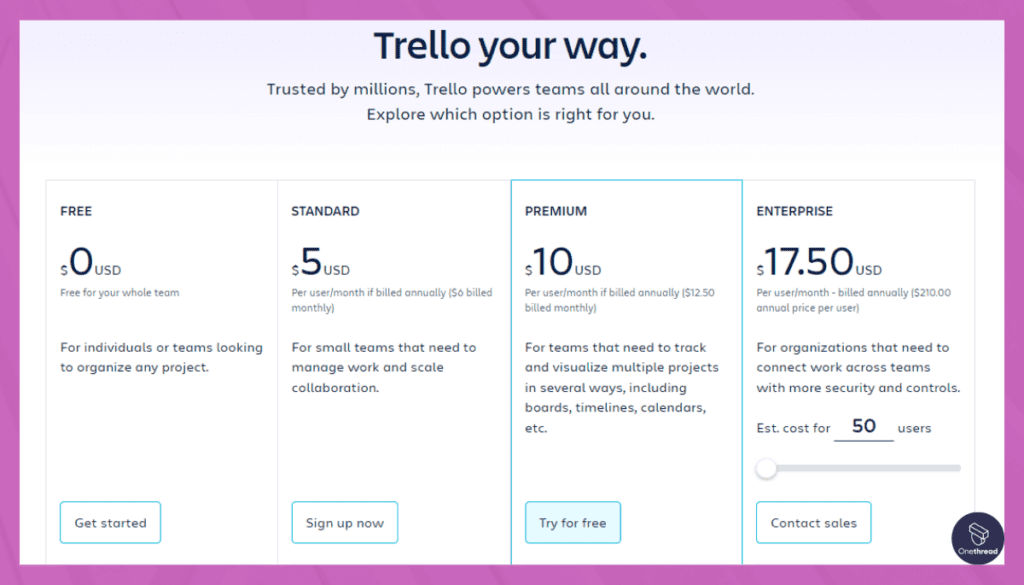
- Free Plan: Basic boards and lists with limited Power-Ups.
- Business Class: $10/user per month with unlimited Power-Ups and additional features.
- Enterprise: Custom pricing with advanced admin and security features.
Customer Ratings
- G2: 4.3 out of 5 stars
- Capterra: 4.5 out of 5 stars
Review
Trello excels in visual task management. It’s user-friendly, with drag-and-drop features making project organization simple. Collaboration is easy too. Team members can comment and upload files directly onto cards.
However, Trello lacks advanced features like time-tracking or built-in analytics, making it less suitable for complex projects. Also, while the free version offers good basics, you’ll need a paid plan for robust customization.
Overall, Trello is great for small teams and straightforward projects but may require third-party integrations for more complex needs.
#3. Asana
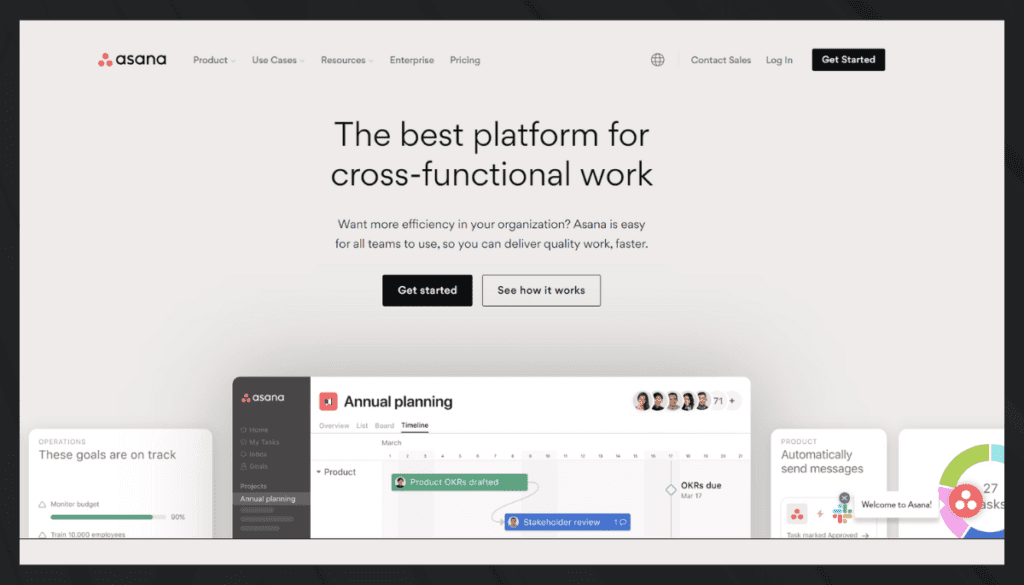
Asana is a powerful project management and task tracking tool designed to boost productivity. With its intuitive interface, Asana simplifies task management for teams of all sizes.
You can create projects, assign tasks, and set deadlines effortlessly. Asana also offers customizable views, including lists, boards, and timelines, to fit your workflow.
It fosters collaboration with features like file attachments and commenting. Integration with popular apps like Google Workspace and Slack enhances communication.
The mobile app ensures you stay connected while on the move. Whether you’re managing a project or personal to-dos, Asana helps you stay organized and focused.
Asana – Overview
Product Information:
- Company Valuation: $3.79 billion as of September 22, 2023.
- Employee Numbers: 1,782 (2023)
Founding Team: Asana, Inc. was founded in 2008 by Dustin Moskovitz and Justin Rosenstein.
Features
Let’s dig deep into its pivotal features, assess its pros and cons, examine pricing options, and check out what users have to say.
Task Assignments and Timelines
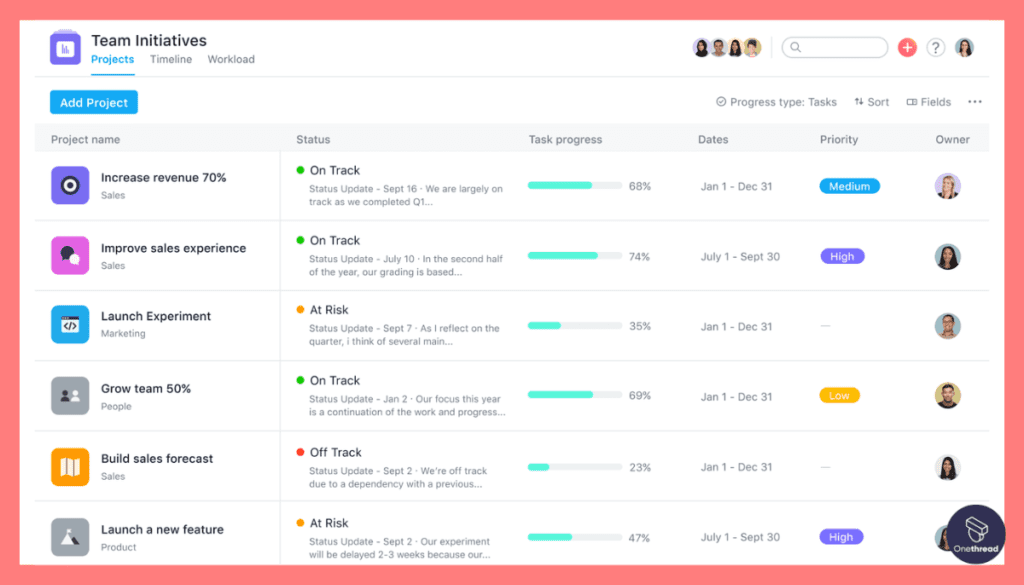
Asana excels at breaking down projects into tasks and sub-tasks, which can be easily assigned to team members. With its intuitive timelines, you can visualize the flow of a project from start to finish. Deadlines, dependencies, and milestones are clearly marked. The timeline feature ensures that everyone knows their responsibilities, how long they have to complete them, and how their tasks fit into the larger project scope.
Real-time Collaboration and Communication
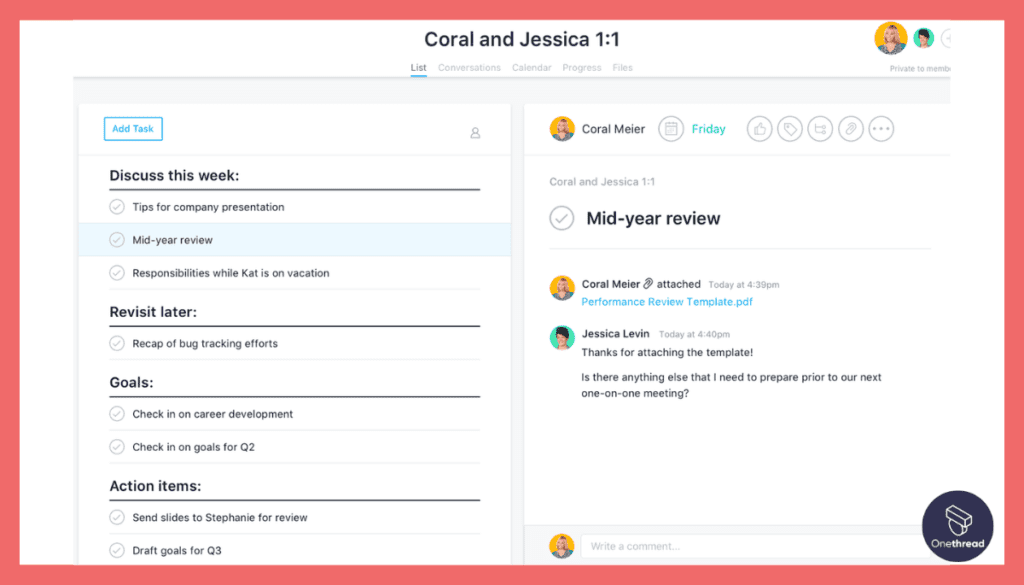
Staying connected is crucial in Agile projects, and Asana makes it effortless. Built-in chat, comments, and notifications keep the team in the loop without having to exit the app. This central hub of information means questions are answered quickly, updates are immediate, and team members are consistently aligned with project goals.
Custom Fields and Tags
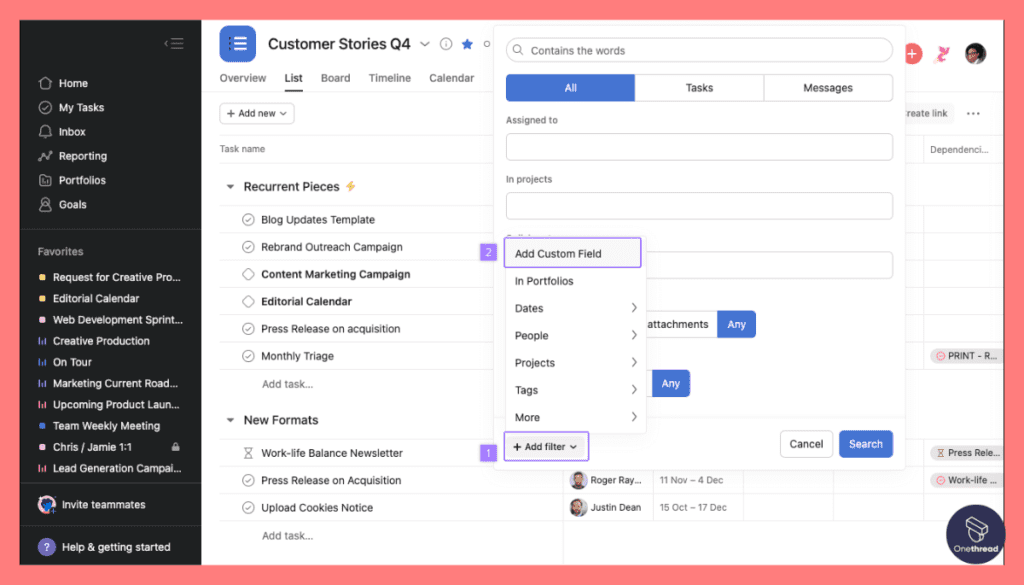
Customization is one of Asana’s strong suits. The platform allows users to add custom fields and tags to tasks. This way, you can track whatever metrics matter most to your project, be it priority levels, cost, or any other custom criteria. This level of customization ensures that Asana can adapt to the unique needs of any project or organization.
Workspaces and Portfolios
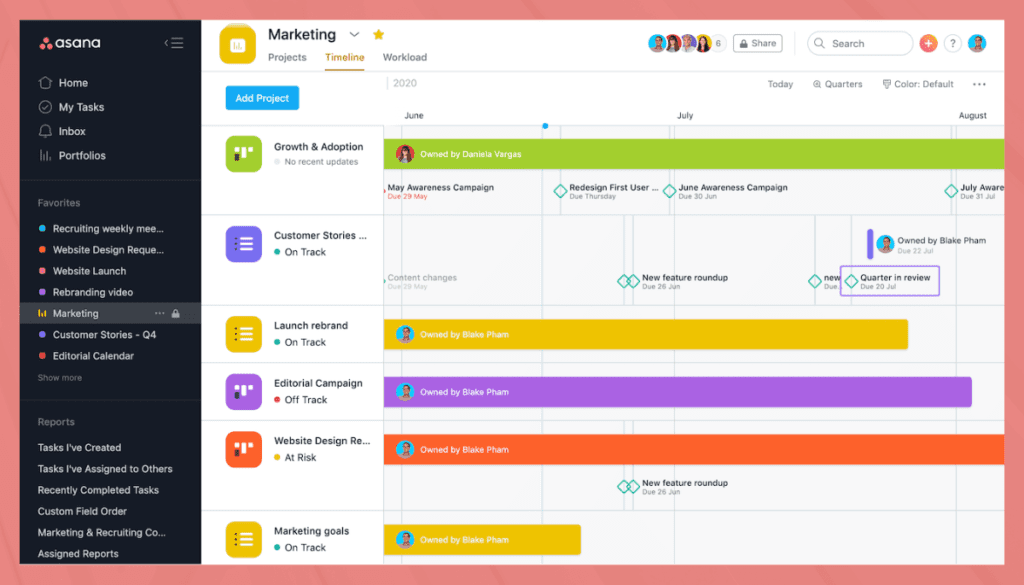
Workspaces are Asana’s answer to managing multiple projects simultaneously. Within a workspace, you can have multiple projects, each with its tasks and timelines. Portfolios offer a higher-level view, allowing managers to track the progress of multiple workspaces at once. These features make Asana incredibly scalable, suitable for teams and organizations of varying sizes.
Automation and Integrations
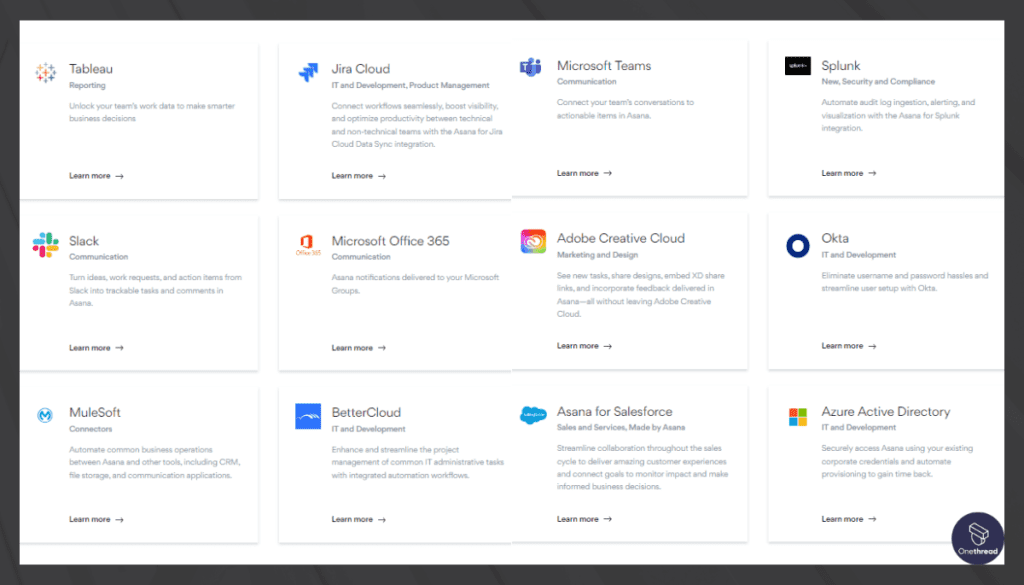
Nobody likes manual, repetitive work. Asana’s automation features allow you to set up rules to handle routine tasks. Additionally, Asana integrates seamlessly with a host of other tools such as Slack, Google Drive, and GitHub. This means you can keep using your favorite apps without sacrificing the centralized control that Asana offers.
Pros & Cons
Pros:
- Highly customizable to suit various project needs.
- Exceptional collaboration and communication features.
- Robust automation capabilities.
- User-friendly interface with extensive onboarding resources.
Cons:
- Can become complex and overwhelming for small projects.
- Some advanced features are locked behind higher pricing tiers.
Pricing Plans
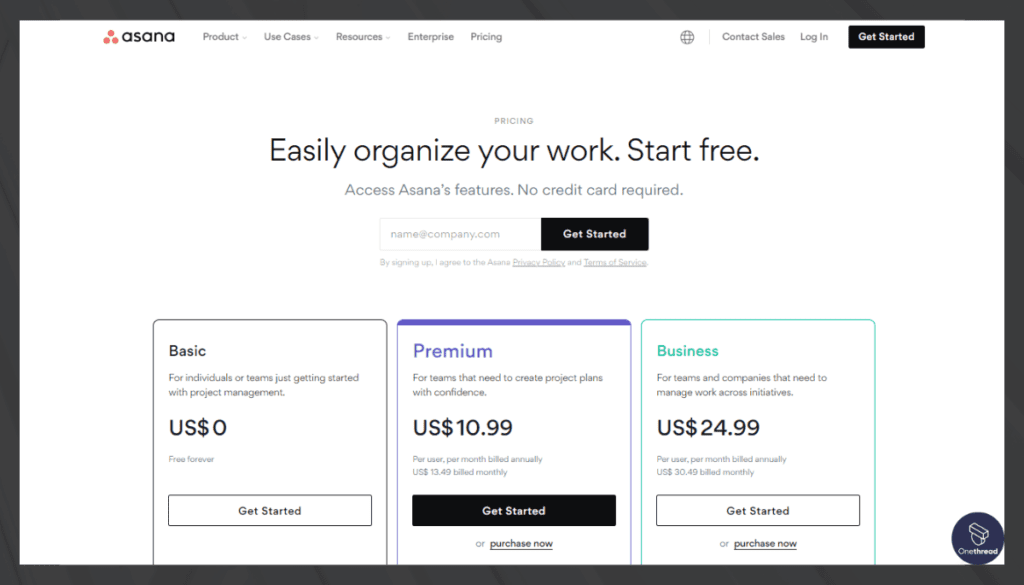
- Basic: Free plan with limited features and tasks.
- Premium: $10.99/user per month, featuring advanced search, timelines, and more.
- Business: $24.99/user per month, including automation and custom rules.
Customer Ratings
- G2: 4.3 out of 5 stars
- Capterra: 4.4 out of 5 stars
Review
Asana is a popular project management tool. It’s user-friendly with an intuitive interface. Collaboration is easy. Teams can track progress and set deadlines. The mobile app is also solid.
However, it’s not perfect. The free version is limited. Advanced features require payment. It can also get complex when managing large projects. Sometimes, it’s too feature-rich, making it overwhelming for new users.
Overall, Asana balances good design with powerful features. But the costs and complexity can be a downside for some. It’s a solid choice for medium-sized teams but may require a learning curve.
#4. ClickUp
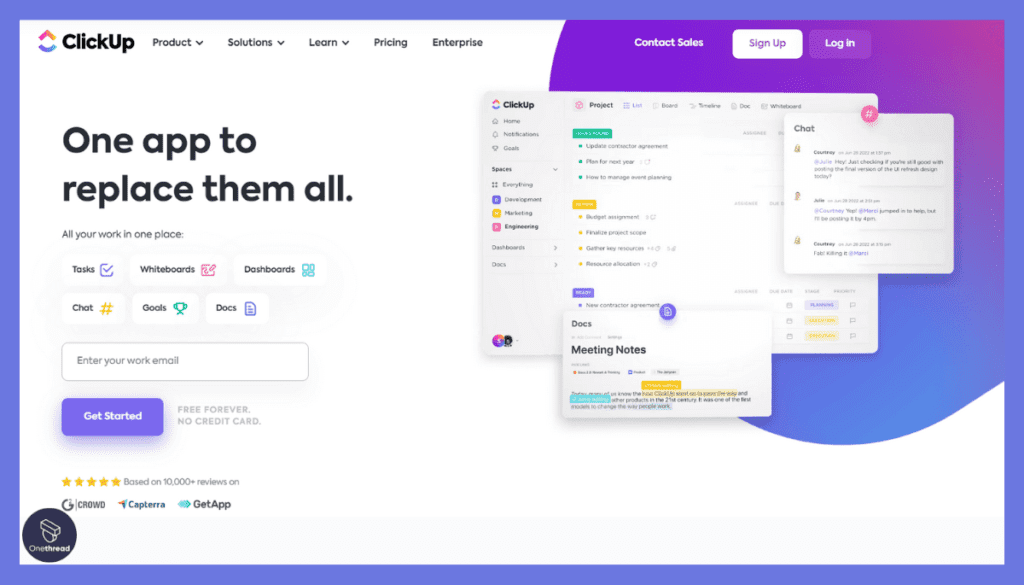
ClickUp is a comprehensive productivity and project management platform designed for teams and individuals. It offers a user-friendly interface that simplifies task management. With ClickUp, you can create tasks, assign them, and set priorities effortlessly.
It provides a range of views, including lists, boards, and timelines, to suit your workflow preferences. ClickUp also fosters collaboration through file sharing, comments, and integrations with tools like Google Drive and Slack.
The mobile app ensures you can stay productive on the go. What sets ClickUp apart is its flexibility to adapt to various work styles and industries. Whether you’re managing projects or personal tasks, ClickUp empowers you to stay organized and efficient.
ClickUp – Overview
Product Information:
- Company Valuation: $4 billion.
- Employee Numbers: 1,000 employees.
Founding Team:
The company was founded in 2017 by Zeb Evans and Alex Yurkowski.
Features
Let’s dissect ClickUp’s standout features, weigh the pros and cons, explore pricing options, and check out what customers are saying.
Task Management and Time Tracking
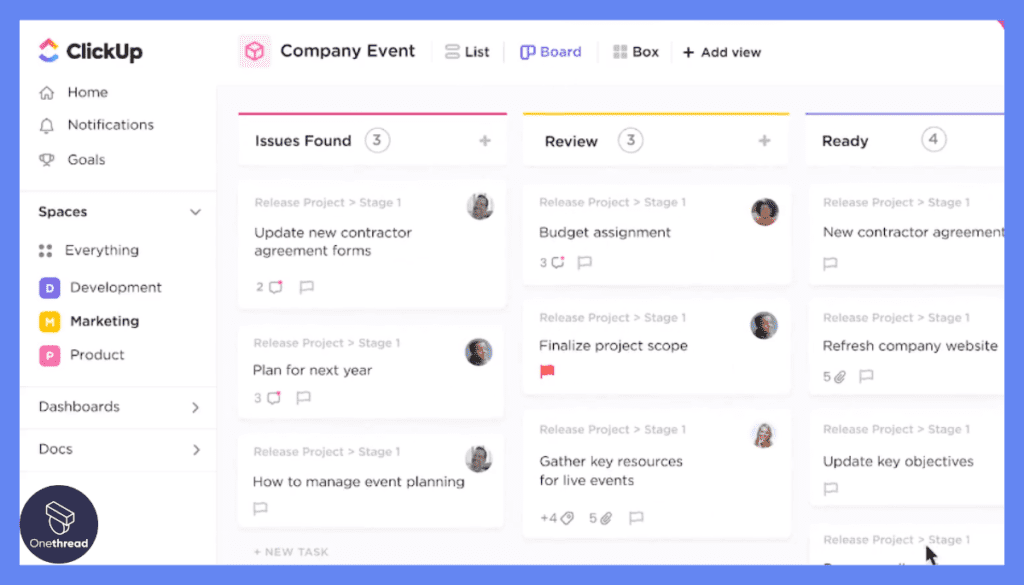
ClickUp is not just a task manager; it’s a task manager with built-in time tracking. Assign tasks, set deadlines, and monitor how much time is being spent on each task, all within the same platform. This dual feature eliminates the need for a separate time tracking tool, streamlining your project management process. It also provides invaluable data to make future projects more efficient.
Goal Setting and OKRs
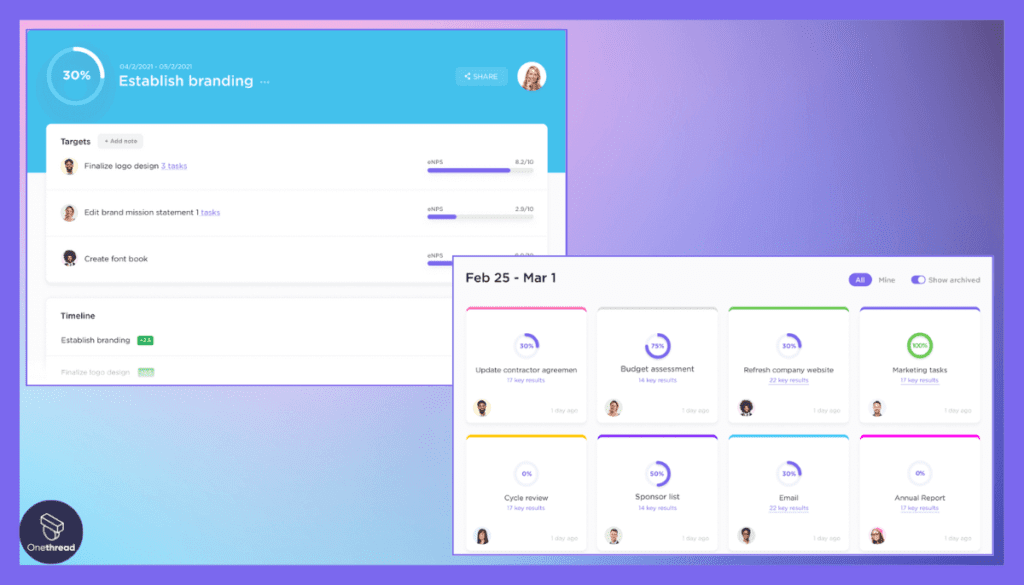
ClickUp goes beyond tasks and projects by incorporating goal-setting features, aligned with Objectives and Key Results (OKRs). You can define your objectives at a team or company level, break them down into key results, and track your progress in real-time. This brings an extra layer of strategy to your project management, ensuring that every task and project aligns with larger organizational goals.
Custom Views
Different teams have different needs, and ClickUp gets that. You can customize your workspace view to include lists, boards, calendars, or a Gantt chart. These custom views allow team members to interact with projects in a way that makes the most sense for them, increasing overall productivity and satisfaction.
Automation and Integrations
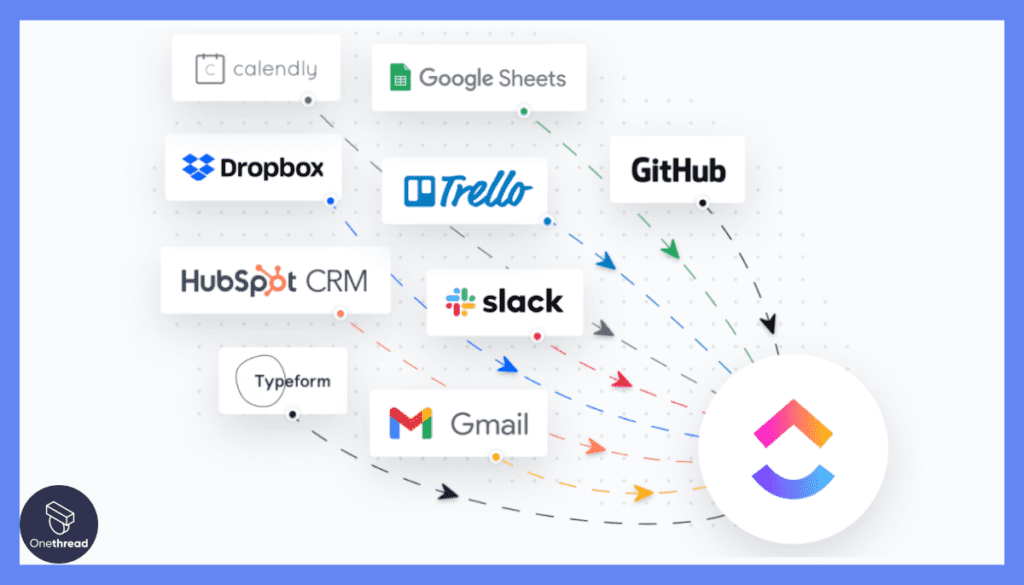
Automation is another strong point for ClickUp. With its automation features, you can set up rules to take care of repetitive tasks, like assigning new tasks to team members based on their workload. It also offers an impressive array of integrations with other tools such as Google Drive, Slack, and even Asana, making it versatile enough to fit into any existing tool ecosystem.
Reporting and Analytics
Knowledge is power, and ClickUp’s reporting and analytics features offer deep insights into project performance. Track key metrics like task completion rates, time spent, and team productivity levels. Use this data to make informed decisions that will make your next Agile project even more successful.
Pros & Cons
Pros:
- Comprehensive all-in-one platform.
- Extensive customization options.
- Built-in time tracking and goal setting.
- A wide range of integrations.
Cons:
- Steeper learning curve compared to simpler tools.
- Some advanced features require a paid plan.
Pricing Plans
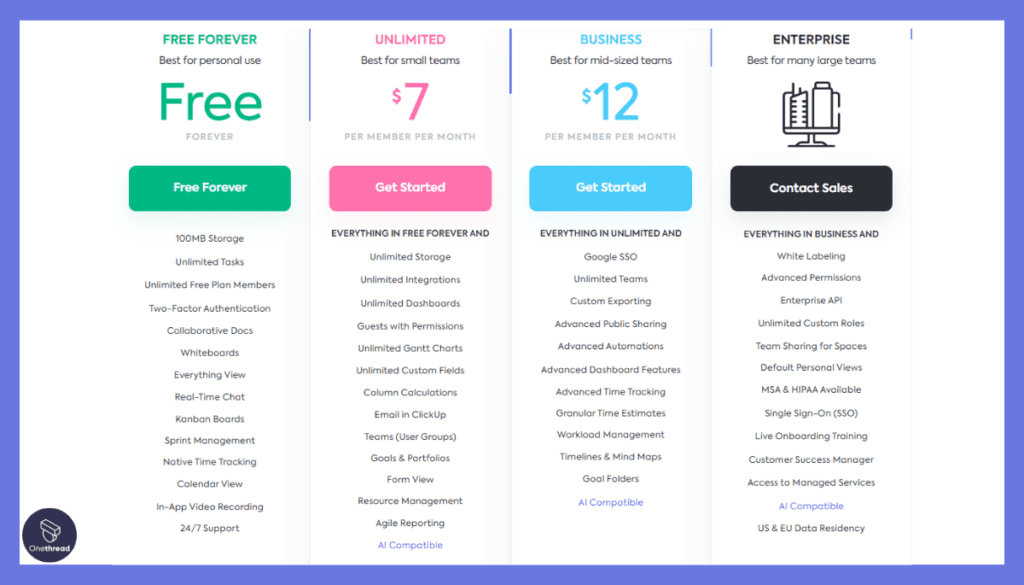
- Free Forever: Includes unlimited tasks and members but limited features.
- Unlimited: $5/user per month with unlimited features.
- Business: $9/user per month, includes advanced reporting and one-on-one training.
Customer Ratings
- G2: 4.7 out of 5 stars
- Capterra: 4.7 out of 5 stars
Review
ClickUp is another project management tool gaining traction. It offers versatility with multiple views like list, board, and calendar. Customization is a strong point; you can tailor almost every aspect. Automation features save time on repetitive tasks.
On the flip side, the tool has drawbacks. The user interface can feel cluttered due to its many features. This makes the learning curve steep for newcomers. The mobile app lags behind its desktop counterpart in terms of functionality.
In summary, ClickUp offers robust features and customization but can overwhelm new users. It’s ideal for teams that need high levels of personalization, though beginners may find it complex.
#5. Monday.com
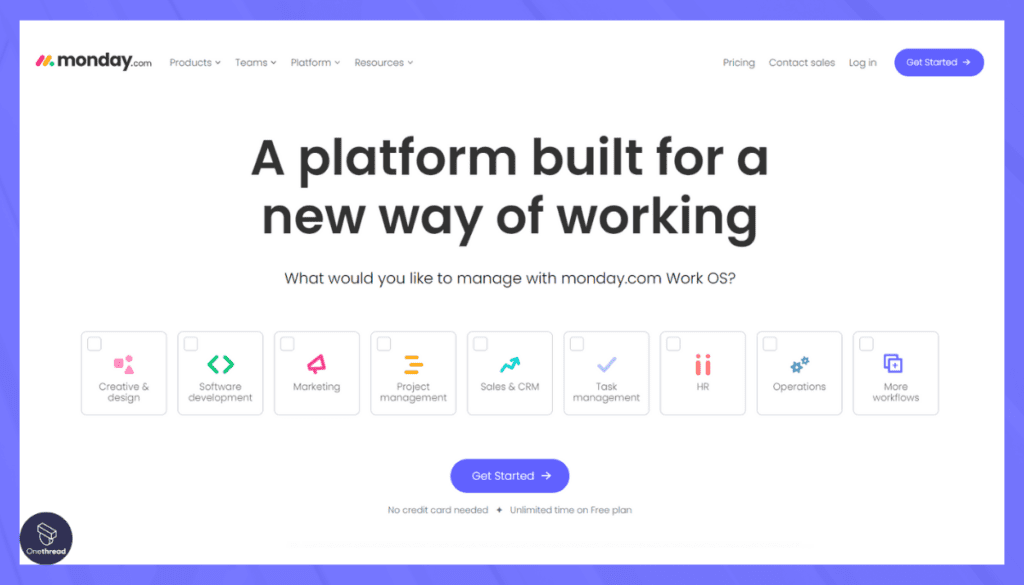
Monday.com is a dynamic work operating system that elevates team collaboration and project management. Its intuitive interface simplifies task tracking and workflow optimization. You can easily create projects, assign tasks, and establish deadlines, ensuring everyone stays on track.
Monday.com offers a range of customizable views, from boards to timelines, to adapt to your specific needs. It promotes teamwork through file sharing, comments, and seamless integrations with popular apps like Slack and Google Workspace.
The mobile app keeps you connected and productive while on the move. What sets Monday.com apart is its flexibility, making it suitable for various industries and work styles. Whether you’re managing a complex project or daily tasks, Monday.com empowers you to streamline your work and achieve exceptional results.
Monday.com- Overview
Product Information:
- Company Valuation: $7.58 billion as of September 22, 2023.
- Employee Numbers: 1,001-5,000 employees
Founding Team:
Founded by Roy Mann & Eran Zinman.
Features
From startups to Fortune 500 companies, Monday.com offers features that make Agile practices efficient and straightforward. Let’s delve into the specifics, look at its pros and cons, examine the pricing, and hear what customers have to say.
Visual Boards for Workflow Management
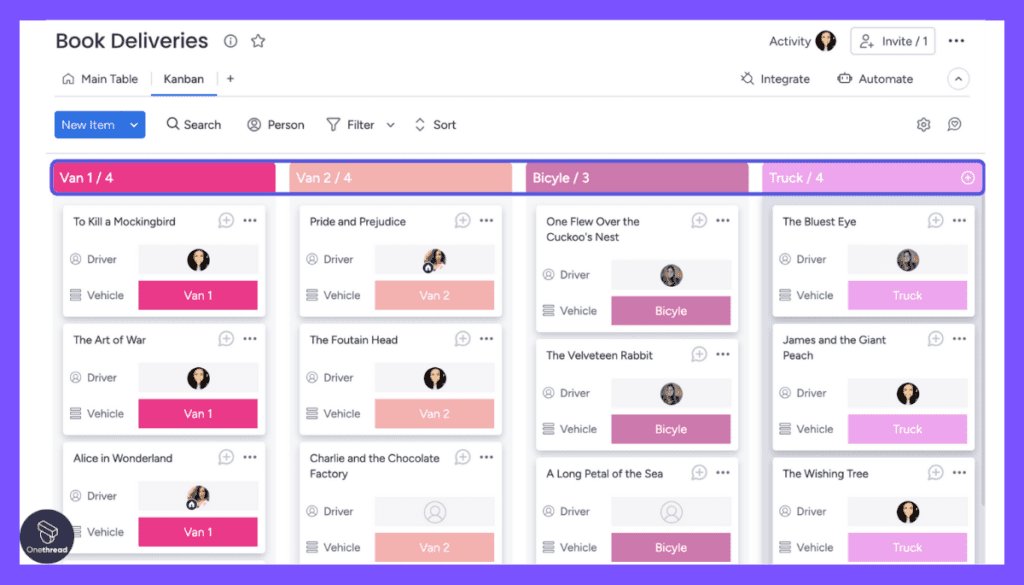
Monday.com shines in the realm of visual project management. Its board-based layout allows you to see tasks, timelines, and team responsibilities at a glance. These boards are not just eye-candy; they enable real-time tracking and immediate updates. This offers the clarity and quick adjustments vital for Agile teams, all within a single, intuitive interface.
Automation and Bots
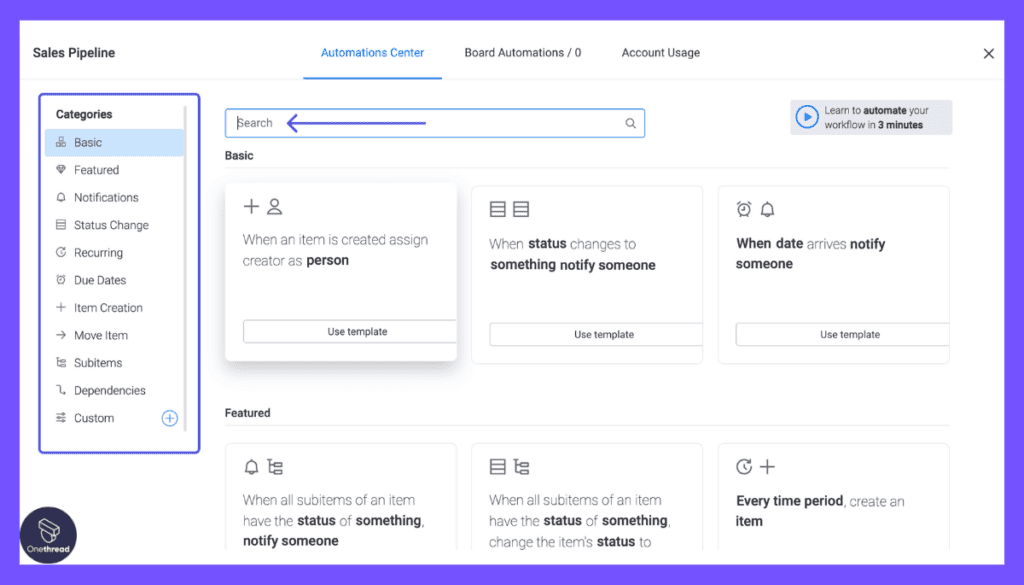
Automate repetitive work with Monday.com’s robust automation features. Create custom workflows using bots that perform actions like sending reminders, updating statuses, or assigning tasks. This automation is particularly useful for Agile teams, as it frees up time for more important work, like problem-solving and innovating.
Integration Capabilities
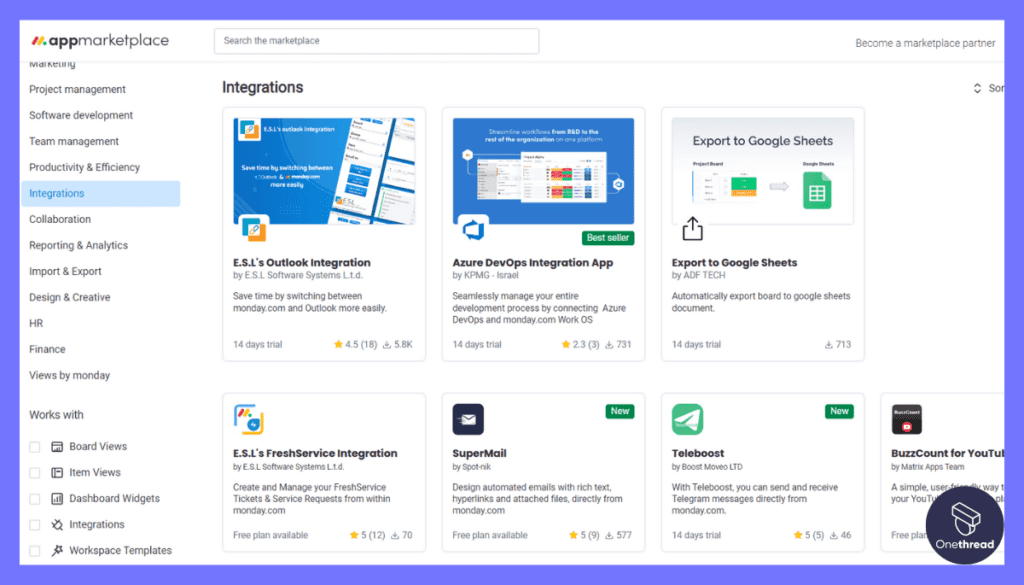
If your team is using a mix of tools, Monday.com could be the glue that holds everything together. The platform boasts over 200 integrations, from Asana and Trello to Slack and Microsoft Teams. This makes it easy to import tasks, sync calendars, or link databases. Its integrative nature ensures you don’t need to abandon your favorite tools to benefit from Monday.com’s features.
Dashboards and Reporting
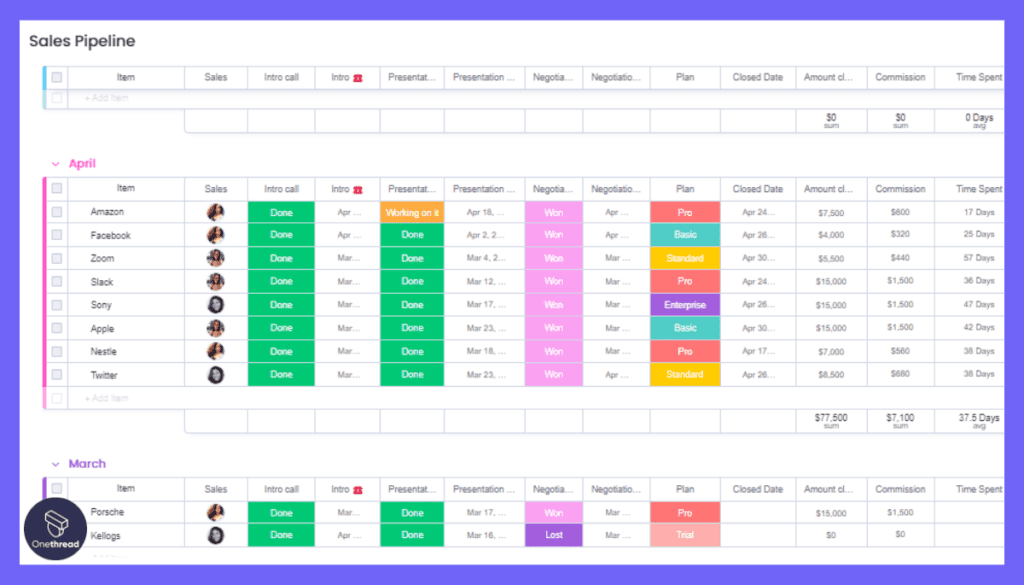
For those who love metrics and analytics, Monday.com offers customizable dashboards. These dashboards can track a variety of KPIs, from project completion rates to individual performance metrics. It’s a game-changer for Agile teams who want to continuously improve their processes based on real, actionable data.
Collaboration and Communication
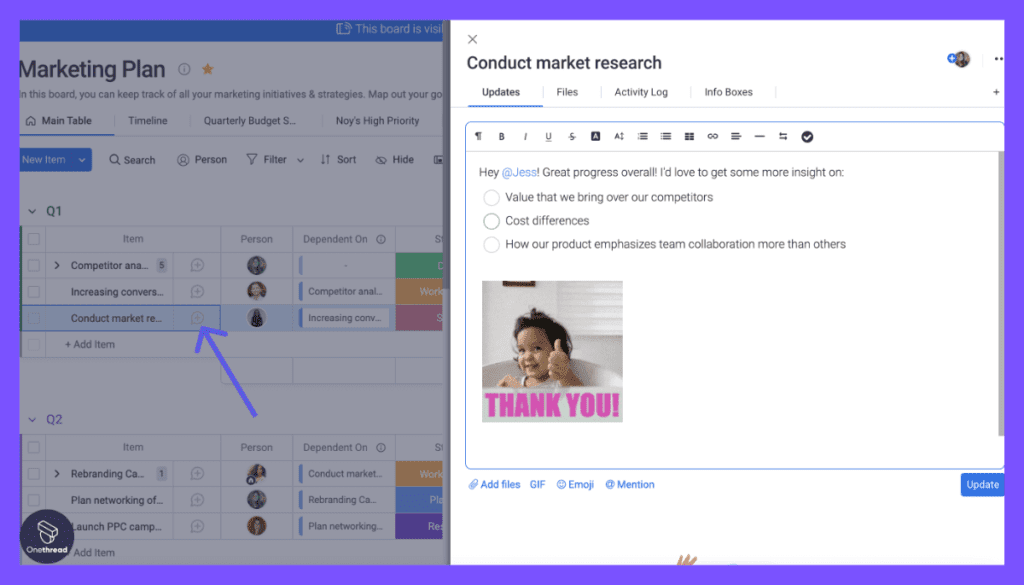
One of Monday.com’s standout features is its focus on team collaboration. With built-in chat options, video conferencing, and document sharing, it aims to be a one-stop-shop for all communication needs. No need to switch between tools; everything is available within the platform, making collaboration seamless and efficient.
Pros & Cons
Pros:
- Extremely customizable with visual boards.
- Powerful automation features.
- Wide range of integrations.
- Robust reporting and analytics.
Cons:
- Could be overwhelming for smaller teams due to feature richness.
- Pricing can be on the higher side for advanced features.
Pricing Plans
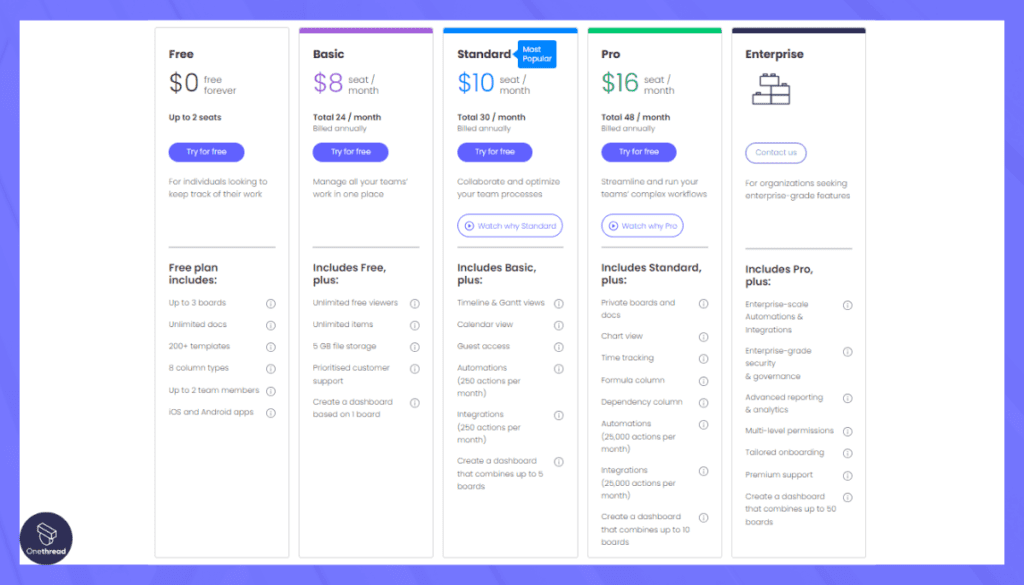
- Individual: Free for single users, limited features.
- Basic: $8/user per month, offers core features.
- Standard: $10/user per month, includes timeline views and automations.
- Pro: $16/user per month, advanced analytics and integrations.
Customer Ratings
- G2: 4.6 out of 5 stars
- Capterra: 4.6 out of 5 stars
Review
Monday.com is a project management platform that stands out for its visual appeal and user-friendly interface. The software is highly customizable, allowing for easy adaptation to various work environments. Collaboration is streamlined, with real-time updates and communication features.
However, there are downsides. The pricing can be on the higher end, especially for smaller teams or startups. While the software is feature-rich, this can sometimes lead to a cluttered workspace. Some users report that the sheer number of options can make the tool confusing and less straightforward to navigate.
In conclusion, Monday.com excels in customization and user experience but may be costly and overwhelming for some. It’s a good fit for larger teams that need flexibility but may be overkill for simpler projects.
Getting the Most Out of Agile Tools

Agile tools can revolutionize your project management, but only if used correctly. Here’s how to get the most bang for your buck.
- Set Clear Objectives: Know what you’re aiming to achieve with the Agile tool. Align it with your team’s or company’s goals.
- Customize Wisely: Most Agile tools offer customization. Tailor it to fit your workflow, not the other way around.
- Train Your Team: A tool is only as good as the people using it. Make sure everyone is well-versed in how to use it effectively.
- Regular Updates: Keep all team members in the loop. Use the tool’s communication features to ensure everyone is up-to-date.
- Analyze Data: Use built-in analytics to track performance. Adapt and improve your strategies based on real metrics.
By adhering to these best practices, you can ensure that your Agile tool serves as a genuine asset rather than just another software to manage.
Summary
Agile tools are not just software; they’re catalysts for organizational change. They offer a structured yet flexible framework for managing complex projects, promoting transparency and real-time collaboration.
By choosing the right tool and employing best practices, teams can elevate their efficiency and responsiveness to new levels. Ultimately, a well-implemented Agile tool can be a game-changer for your projects and your entire organization.
FAQs
Is it necessary to have training to use Agile Tools?
While some Agile tools are user-friendly, formal training can help you make the most of all the features available. Many platforms offer tutorials and customer support to assist with this.
Can I use Agile Tools for remote teams?
Absolutely. Agile tools are often cloud-based, making them ideal for remote teams. They help keep everyone on the same page, regardless of location.
Are Agile Tools Expensive?
Costs can vary. Many platforms offer free basic plans with the option to upgrade to more feature-rich packages. Generally, the more advanced the features, the higher the cost.
Can I integrate Agile Tools with other software?
Yes, most Agile tools offer various integrations with other platforms like Slack, Google Drive, and CRM software, allowing you to streamline your workflow.
